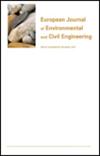Dredged marine sand as construction material
IF 2.3
4区 工程技术
Q2 ENGINEERING, CIVIL
European Journal of Environmental and Civil Engineering
Pub Date : 2012-09-03
DOI:10.1080/19648189.2012.676376
引用次数: 26
Abstract
Dredging works are usually required to maintenance activities in many ports all over the world and represents a huge volume of disposal material. The use of dredged aggregates can be considered in several applications as erosive process control, coastal stabilization, beach replenishment, production of construction materials (clay, bricks, aggregates) or construction works (foundation fill, dikes, etc.). Researches revealed the feasibility of dredged marine sand (DMS) in the construction of base and sub-base harbour pavements incorporating this material to hydraulic binder mixes (cement or lime) in order to improve the grading of aggregates and correct the granular skeleton. Its main objective is to improve the packing and to obtain the compressive properties required for geotechnical applications. In this work the study of DMS from the Port of Sant Carles de la Rapita (Tarragona, Spain) as construction material is presented. The analysis of its influence on paste, mortar and concrete production is described. Two experimental phases were carried out once chemical and physical characteristics of DMS were determined. At first, pastes and mortars were made using CEM II/A-M 42,5R cement, different percentages of DMS on replacement of raw sand and plasticizer additive in order to obtain fresh and hardened properties of the mixes studied. After that, DMS was used in the production of concretes as fine aggregates. A pilot experience was carried out with concrete port pavements produced in industrial scale. Fresh and hardened properties of the concretes were determined and compared to the control mix. Results show satisfactory behaviour of DMS as construction material when incorporated in concrete as fine corrective sand.疏浚海砂作为建筑材料
在世界各地的许多港口,疏浚工程通常是维护活动所需要的,并且代表了大量的处置材料。疏浚集料的使用可以考虑在以下几种应用中:侵蚀过程控制、海岸稳定、海滩补给、建筑材料(粘土、砖、集料)的生产或建筑工程(地基填筑、堤防等)。研究表明,将疏浚海砂(DMS)与水力粘结剂(水泥或石灰)混合在一起,可以改善集料的级配并纠正颗粒骨架,从而在基层和次基层港口路面的施工中具有可行性。其主要目的是改善填料和获得岩土工程应用所需的抗压性能。在这项工作中,研究了来自圣卡莱斯德拉拉皮塔港(塔拉戈纳,西班牙)的DMS作为建筑材料。分析了其对膏体、砂浆和混凝土生产的影响。在确定了DMS的化学和物理特性后,进行了两个阶段的实验。首先,采用CEMⅱ/A-M 42,5r水泥,用不同比例的DMS替代原砂和增塑剂添加剂,制成膏体和砂浆,以获得所研究的混合料的新鲜和硬化性能。之后,DMS作为细骨料被用于生产混凝土。以工业规模生产的混凝土港口路面进行了试点经验。测定了混凝土的新鲜和硬化性能,并与对照混合料进行了比较。结果表明,DMS作为细砂掺入混凝土中,具有良好的施工性能。
本文章由计算机程序翻译,如有差异,请以英文原文为准。
求助全文
约1分钟内获得全文
求助全文
来源期刊

European Journal of Environmental and Civil Engineering
ENGINEERING, CIVIL-ENGINEERING, GEOLOGICAL
CiteScore
4.80
自引率
4.80%
发文量
153
审稿时长
6 months
期刊介绍:
The European Research Area has now become a reality. The prime objective of the EJECE is to fully document advances in International scientific and technical research in the fields of sustainable construction and soil engineering. In particular regard to the latter, the environmental preservation of natural media (soils and rocks) and the mitigation of soil-related risks are now not only major societal challenges, but they are also the source of scientific and technical developments that could be extremely beneficial.
 求助内容:
求助内容: 应助结果提醒方式:
应助结果提醒方式:


